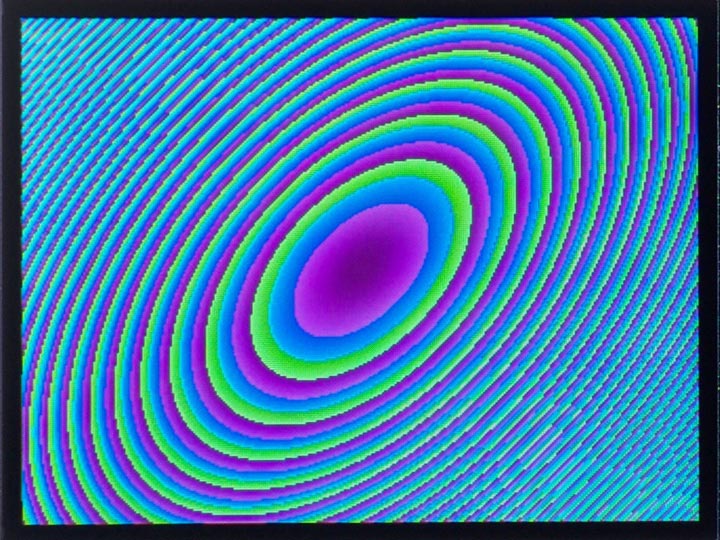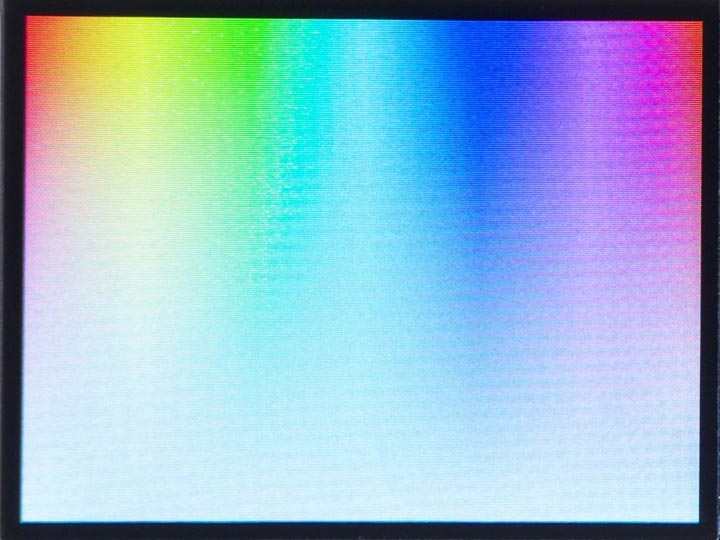Graphics utilities
The following utilities and simple demos show the use of the graphics extensions, available in several versions of uLisp.
RGB utility
These routines make use of the following rgb utility to define a colour from its RGB components:
(defun rgb (r g b) (logior (ash (logand r #xf8) 8) (ash (logand g #xfc) 3) (ash b -3)))
Each of the parameters r, g, and b should be an integer from 0 to 255. For example, to define orange you could use:
(defvar *orange* (rgb 255 128 0))
Coloured ellipses

This simple demo displays a series of coloured ellipses:
(defun plot ()
(dotimes (xx 320)
(let ((x (- xx 160)))
(dotimes (yy 240)
(let* ((y (- yy 120))
(f (truncate (+ (* x (+ x y)) (* y y)) 8)))
(draw-pixel xx yy (rgb (+ f 160) f (+ f 80))))))))
It plots the value of x2 + y2 + xy as a function of x and y.
HSV utility

This routine allows you to specify colours in the alternative HSV colour system (also called HSB) [1].
(defun hsv (h s v)
(let* ((chroma (* v s))
(x (* chroma (- 1 (abs (- (mod (/ h 60) 2) 1)))))
(m (- v chroma))
(i (truncate h 60))
(params (list chroma x 0 0 x chroma))
(r (+ m (nth i params)))
(g (+ m (nth (mod (+ i 4) 6) params)))
(b (+ m (nth (mod (+ i 2) 6) params))))
(rgb (round (* r 255)) (round (* g 255)) (round (* b 255)))))
It's useful because, for particular fixed values of s and v, you can generate a range of different colours of similar brightness and saturation simply by varying the h parameter.
It takes the following parameters:
- h is the hue, which can be from 0 to 359, representing degrees around a colour circle.
- s is the saturation, which can be from 0, representing white, to 1.0, representing 100% saturation.
- v is the value, which can be from 0, representing black, to 1.0, representing 100% brightness.
The following routine generates the plot shown above of hue horizontally against saturation vertically, with value = 100%:
(defun plot ()
(set-rotation 2)
(fill-screen)
(dotimes (x 320)
(dotimes (y 240)
(draw-pixel x y (hsv (/ (* x 360) 320) (/ y 240) 1)))))
Sierpinski curve

This is a recursively-defined curve. It starts with a triangle constructed from three squares; then each square is replaced by a triangle of smaller squares, and so on. Each generation is shown in a different colour:
(defun sierpinski (x0 y0 size gen)
(when (plusp gen)
(let ((s (ash size -1))
(n (1- gen)))
(fill-rect x0 y0 size size (col gen))
(sierpinski (+ x0 (ash s -1)) y0 s n)
(sierpinski x0 (+ y0 s) s n)
(sierpinski (+ x0 s) (+ y0 s) s n))))
The following function col defines a different colour for each value of n from 0 to 7:
(defun col (n) (rgb (* (logand n 1) 160) (* (logand n 2) 80) (* (logand n 4) 40)))
Finally, this function draw draws the above plot showing 7 generations:
(defun draw ()
(set-rotation 2)
(fill-screen)
(sierpinski 40 0 240 7)) - ^ HSL and HSV on Wikipedia.
